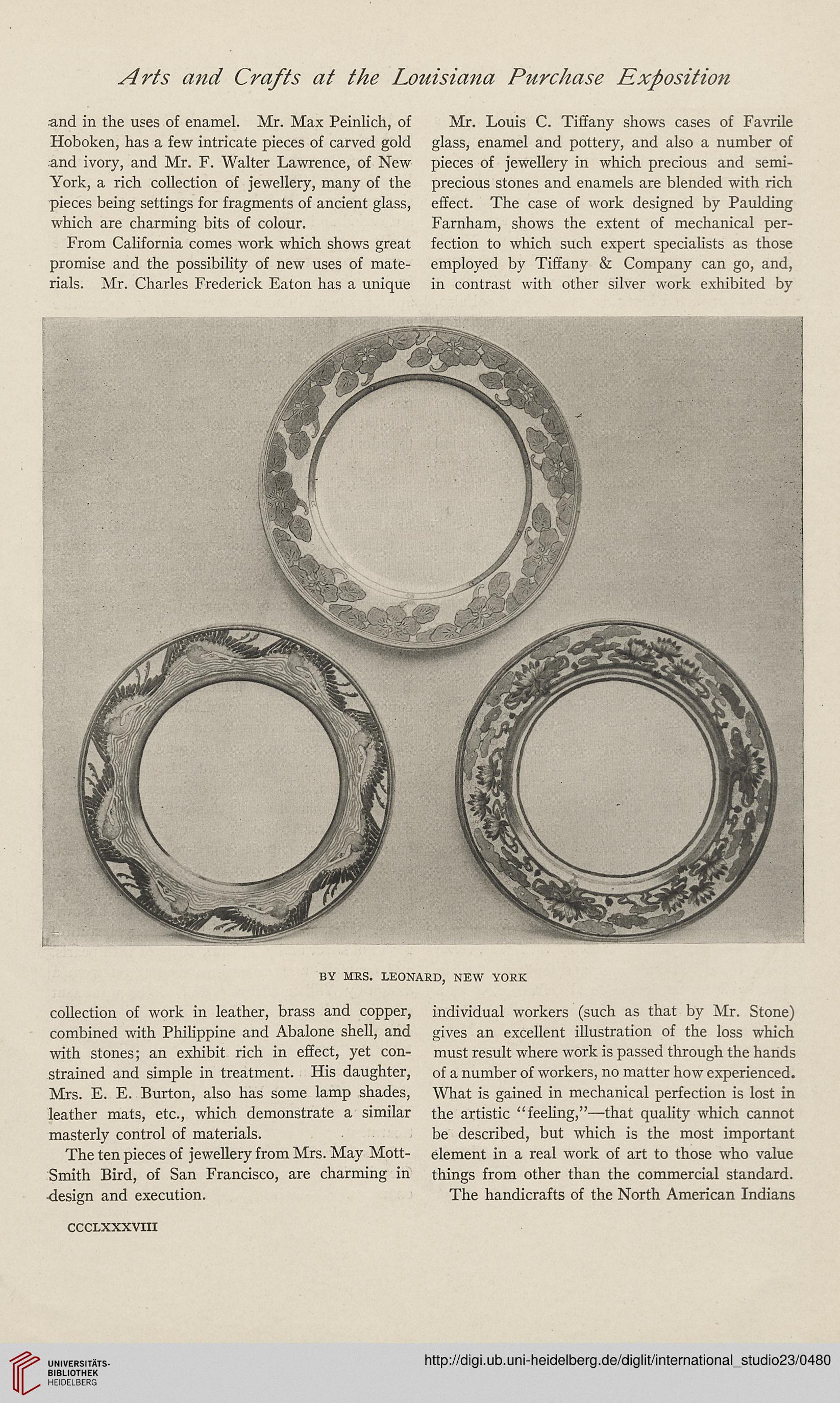Arts and Crafts at the Louisiana Purchase Exposition
and in the uses of enamel. Mr. Max Peinlich, of
Hoboken, has a few intricate pieces of carved gold
and ivory, and Mr. F. Walter Lawrence, of New
York, a rich collection of jewellery, many of the
pieces being settings for fragments of ancient glass,
which are charming bits of colour.
From California comes work which shows great
promise and the possibility of new uses of mate-
rials. Mr. Charles Frederick Eaton has a unique
Mr. Louis C. Tiffany shows cases of Favrile
glass, enamel and pottery, and also a number of
pieces of jewellery in which precious and semi-
precious stones and enamels are blended with rich
effect. The case of work designed by Paulding
Farnham, shows the extent of mechanical per-
fection to which such expert specialists as those
employed by Tiffany & Company can go, and,
in contrast with other silver work exhibited by
BY MRS. LEONARD, NEW YORK
collection of work in leather, brass and copper,
combined with Philippine and Abalone shell, and
with stones; an exhibit rich in effect, yet con-
strained and simple in treatment. His daughter,
Mrs. E. E. Burton, also has some lamp shades,
leather mats, etc., which demonstrate a similar
masterly control of materials.
The ten pieces of jewellery from Mrs. May Mott-
Smith Bird, of San Francisco, are charming in
design and execution.
individual workers (such as that by Mr. Stone)
gives an excellent illustration of the loss which
must result where work is passed through the hands
of a number of workers, no matter how experienced.
What is gained in mechanical perfection is lost in
the artistic “feeling,”—that quality which cannot
be described, but which is the most important
element in a real work of art to those who value
things from other than the commercial standard.
The handicrafts of the North American Indians
cccLxxxvni
and in the uses of enamel. Mr. Max Peinlich, of
Hoboken, has a few intricate pieces of carved gold
and ivory, and Mr. F. Walter Lawrence, of New
York, a rich collection of jewellery, many of the
pieces being settings for fragments of ancient glass,
which are charming bits of colour.
From California comes work which shows great
promise and the possibility of new uses of mate-
rials. Mr. Charles Frederick Eaton has a unique
Mr. Louis C. Tiffany shows cases of Favrile
glass, enamel and pottery, and also a number of
pieces of jewellery in which precious and semi-
precious stones and enamels are blended with rich
effect. The case of work designed by Paulding
Farnham, shows the extent of mechanical per-
fection to which such expert specialists as those
employed by Tiffany & Company can go, and,
in contrast with other silver work exhibited by
BY MRS. LEONARD, NEW YORK
collection of work in leather, brass and copper,
combined with Philippine and Abalone shell, and
with stones; an exhibit rich in effect, yet con-
strained and simple in treatment. His daughter,
Mrs. E. E. Burton, also has some lamp shades,
leather mats, etc., which demonstrate a similar
masterly control of materials.
The ten pieces of jewellery from Mrs. May Mott-
Smith Bird, of San Francisco, are charming in
design and execution.
individual workers (such as that by Mr. Stone)
gives an excellent illustration of the loss which
must result where work is passed through the hands
of a number of workers, no matter how experienced.
What is gained in mechanical perfection is lost in
the artistic “feeling,”—that quality which cannot
be described, but which is the most important
element in a real work of art to those who value
things from other than the commercial standard.
The handicrafts of the North American Indians
cccLxxxvni




